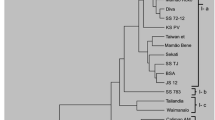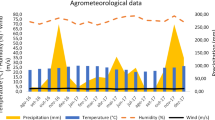Abstract
The papaya (Carica papaya L.) breeding program carried out by UENF has endeavored to develop resistant genotypes. A way to obtain such materials and broaden their genetic base is by incorporating resistance alleles extracted from dioecious genotypes into breeding programs. This study aimed to examine the morpho-agronomic attributes and aspects of resistance to black spot and phoma spot in a new hermaphrodite genotype (H-M3), which was identified in a resistant dioecious progeny (PD-M3). Twenty-one traits were evaluated in six genotypes in a randomized-block design with ten replicates and two plants per plot. Analysis of variance and means test were performed. Genetic parameters and divergence analysis were performed. The H-M3 genotype was near to ‘Calimosa’ and Maradol in the analyzed clusters, indicating good morpho-agronomic attributes and resistance. The proximity of H-M3 to the Maradol genotype is important since Maradol has already been reported as being resistant to black spot and exhibiting lower severity and incidence of phoma spot. Therefore, H-M3 emerges as a promising material for papaya breeding, as it encompasses favorable agronomic traits and moderate resistance.






Similar content being viewed by others
Abbreviations
- AFW:
-
Average fruit weight
- CCC:
-
Cophenetic correlation coefficient
- CVe:
-
Experimental coefficient of variation
- CVg:
-
Genotypic coefficient of variation
- FD:
-
Fruit diameter
- FF:
-
Fruit firmness
- FL:
-
Fruit length
- HIFF:
-
Height insertion of the first fruit
- H-M3:
-
Hermaphrodite
- H2 :
-
Genotypic coefficient of determination
- IBSF:
-
Incidence of black spot in the fruit
- IBSL:
-
Incidence of black spot in the leaf
- IPSL:
-
Incidence of phoma spot in the leaf
- Iv:
-
Variation index
- NDF:
-
Number of deformed fruits
- NFN:
-
Number of fruitless nodes
- NMF:
-
Number of marketable fruits
- PD-M3:
-
M3 dioecious progeny
- PF:
-
Pulp firmness
- PH:
-
Plant height
- PT:
-
Pulp thickness
- PROD:
-
Production
- SBSF:
-
Severity of black spot in the fruit
- SBSL:
-
Severity of black spot in the leaf
- SD:
-
Stem diameter
- SPSL:
-
Severity of phoma spot in the leaf
- SSC:
-
Soluble solids content
- TNF:
-
Total number of fruits
References
Alvares CA, Stape JL, Sentelhas PC, Gonçalves JLM, Sparovek G (2013) Koppen’s climate classification map for Brazil. Meteorol Z 22:711–728. https://doi.org/10.1127/09412948/2013/0507
AOAC (1990) Official methods of analysis, 13th edn. Association of Official Analytical Chemists, Washington, DC
Barragán-Iglesias J, Méndez-Lagunas LL, Rodríguez-Ramírez J (2018) Ripeness indexes and physicochemical changes of papaya (Carica papaya L. cv. Maradol) during ripening on-tree. Sci Hortic 236:272–278. https://doi.org/10.1016/j.scienta.2017.12.012
Cortes DFM, Santa-Catarina R, Barros GBA, Aredes FAS, Silveira SF, Ferreguetti GA, Ramos HCC, Vianna AP, Pereira MG (2017) Model-assisted phenotypingby digital images in papaya breeding program. Sci Agric 74:294–302. https://doi.org/10.1590/1678-992x-2016-0134
Cruz CD (2013) GENES: a software package for analysis in experimental statistics and quantitative genetics. Acta Sci Agron 35:271–276. https://doi.org/10.4025/actasciagron.v35i3.21251
Cruz CD, Regazzi AJ (1997) Modelos biométricos aplicados ao melhoramento genético. Editora UFV, Viçosa
da Silva FF, Pereira MG, Ramos HCC, Damasceno Junior PC, Pereira TNS, Gabriel APC, Viana AP, Daher RF, Ferreguetti GA (2008) Estimation of genetic parameters related to morpho-agronomic and fruit quality traits of papaya. Crop Breed Appl Biotechnol 8:65–73
Dias NLP, de Oliveira EJ, Dantas JLL (2011) Avaliação de genótipos de mamoeiro com uso de descritores agronômicos e estimação de parâmetros genéticos. Pesq Agropec Bras 46:1471–1479. https://doi.org/10.1590/S0100-204X2011001100008
dos Santos PHD, da Silveira SF, Vivas M, Carvalho BM, Pereira MG (2017) Alternative control to black spot disease in papaya genotypes. Summa Phytopathol 43:60–62. https://doi.org/10.1590/0100-5405/2208
Drew RA, O’Brien CM, Magdalita PM (1998) Development of interspecific Carica hybrids. Acta Hortic 461:285–291
FrutiSéries 7. Mamão (2000) Brasília: Ministério da Integração Nacional. Boletim Informativo
Gabrekiristos E (2020) A newly emerging disease of papaya in Ethiopia: black spot (Asperisporium caricae) disease and management options. J Plant Pathol Microbiol 11:488. https://doi.org/10.35248/2157-7471.20.11.488
Galili T (2015) Dendextend: an R package for visualizing, adjusting and comparing trees of hierarchical clustering. Bioinformatics 31:3718–3720. https://doi.org/10.1093/bioinformatics/btv428
Habib MT, Majumder A, Jakaria AZM, Akter M, Uddin MS, Ahmed F (2018) Machine vision based papaya disease recognition. J King Saud Univ Comput Inf Sci. https://doi.org/10.1016/j.jksuci.2018.06.006
IBGE (2019) Instituto Brasileiro de Geografia e Estatística. Produção Agrícola Municipal. https://www.ibge.gov.br/estatisticas-novoportal/economicas/agricultura-e-pecuaria/9117-producao-agricola-municipal-culturas-temporarias-e-permanentes.html?=&t=resultados. Accessed 25 Sept 2019
Ide CD, Martelleto LAP, Marin SLD, Yamanishi OK (2001) Resposta de diferentes genótipos de mamoeiro à manifestação de varíola. PESAGRO-RIO, Niterói RJ. Comunicado Técnico nº 259
Mantel N (1967) The detection of disease clustering and generalized regression approach. Cancer Res 27:209–220
Martins DS, Ventura JA, Tatagiba JS (2008) Produção Integrada de mamão no Espírito Santo. In: Zambolim L, Nasser LCB, Andrigueto JR, Teixeira JM, Fachinello JC (eds) Produção integrada no Brasil. CNPq, Brasília. Universidade Federal de Viçosa, Viçosa
Pereira MG, de Sousa Poltronieri TP, Pereira TN, Ramos HC, Santa Catarina R, Vettorazzi JC, Arêdes FA, Boechat MS, Venâncio TM, Azevedo AO, Cortes DF (2019) Twenty-two-year papaya breeding program: from breeding strategy establishment to cultivar development. Sci J. https://doi.org/10.35418/2526-4117/v1n2a2
Pirovani AAV, Ramos HCC, Santa-Catarina R, Vettorazzi JCF, Cortes DFM, Boechat MSB, Bohry D, Pereira MG (2018) Hermaphrodite genotype in dioecious papaya progeny: sex reversal or contamination? Euphytica. https://doi.org/10.1007/s10681-018-2304-2
Poltronieri TPS, Silveira SF, Vivas M, Santa Catarina R, Cortes DFM, Azevedo AON, Pereira MG (2017) Selecting black-spot resistant papaya genotypes derived from backcrossing and hybrids. Genet Mol Res. https://doi.org/10.4238/gmr16019401
Poltronieri TP, da Silveira SF, Vivas M, Santa-Catarina R, Azevedo AO, Cortes DF, Pereira MG (2019) Identification of papaya hybrids resistantto Stagonosporopsis caricae by heterosis: a possible reality? Euphytica 215:24. https://doi.org/10.1007/s10681-019-2348-y
Quintal SSR, Viana AP, Gonçalves LSA, Pereira MG, do Amaral Júnior AT, (2012) Divergência genética entre acessos de mamoeiro por meio de variáveis morfoagronômicas. Semina Ciênc Agrár 33:131–142. https://doi.org/10.5433/1679-0359.2012v33n1p131
R Core Team (2018) R: a language and environment for statistical computing. R Foundation for Statistical Computing, Vienna. https://www.R-project.org/
Santa Catarina R, Pereira MG, Vettorazzi JCF, Cortes DFM, de Sousa Poltronieri TP, Azevedo AON, Moreira NF, Miranda DP, de Moraes R, Pirovani AAV, Ramos HCC, Vivas M, Viana AP (2020) Papaya (Carica papaya L.) S1 family recurrent selection: opportunities and selection alternatives from the base population. Sci Hortic 260:108848. https://doi.org/10.1016/j.scienta.2019.108848
Santa-Catarina R, Cortes DFM, Vettorazzi JCF, Ramos HCC, Ferreguetti GA, Pereira MG (2018) Image-based phenotyping of morpho-agronomic traits in papaya fruits (Carica papaya L. THB var.). Aust J Crop Sci 12:1750–1756. https://doi.org/10.21475/ajcs.18.12.11.p1437
Shreedevasena S, Manoranjitham SK, Rajendran L, Parimaladevi R (2019) Detection and molecular characterization of black spot disease of papaya (Carica papaya L.) incited by Asperisporium caricae (Speg.) Maubl. Int J Curr Microbiol App Sci 8(06):511–517. https://doi.org/10.20546/ijcmas.2019.806.059
Vencovsky R (1987) Herança quantitativa. In: Paterniani E, Viegas GP (eds) Melhoramento e produção do milho. Fundação Cargill, Campinas, pp 135–214
Vettorazzi JCF, Santa-Catarina R, de Poltronieri TP, Cortes DFM, Azevedo AON, Pereira DM, Santana JGS, Ramos HCC, Pereira MG (2021) Combining ability of recombined F4 papaya lines: a strategy to select hybrid combination. Sci Agric. https://doi.org/10.1590/1678-992X-2019-0191
Vivas M (2009) Avaliação de germoplasma e híbridos de mamoeiro quanto à resistência às doenças causadas pelos fungos Asperisporium caricae, Colletotrichum gloeosporioides, Oidium caricae e Phomacaricae-papayae. Dissertation (Mestre em Genética e Melhoramento de Plantas) - Campos dos Goytacazes- RJ, Universidade Estadual do Norte Fluminense Darcy Ribeiro
Vivas M, Silveira SF, Terra CEPS, Pereira MG (2010a) Reação de germoplasma e híbridos de mamoeiro à mancha-de-phoma (Phoma caricae-papayae) em condições de campo. Trop Plant Pathol 35:323–328. https://doi.org/10.1590/S1982-56762010000500009
Vivas M, Terra CEPS, Silveira SF, Fontes RV, Pereira MG (2010b) Escala diagramática para avaliação da severidade da pinta-preta em frutos de mamoeiro. Summa Phytopathol 36:161–163. https://doi.org/10.1590/S0100-54052010000200010
Vivas M, Silveira SF, Terra CEPS, Pereira MG (2011) Testers for combining ability and selection of papaya hybrids resistant to fungal diseases. Crop Breed Appl Biotechnol 11:36–42. https://doi.org/10.1590/S1984-70332011000100005
Vivas M, Silveira SF, Vivas JMS, Pereira MG (2012) Patometria, parâmetros genéticos e reação de progênies de mamoeiro à pinta-preta. Bragantia 71:235–238. https://doi.org/10.1590/S0006-87052012005000021
Vivas M, Silveira SF, Pereira MG, Cardoso DL, Ferreguetti GA (2013a) Análise dialélica em mamoeiro para resistência a mancha-de-phoma. Cienc Rural 43:945–950. https://doi.org/10.1590/S0103-84782013005000054
Vivas M, Silveira SF, Vivas JMS, Pereira MG (2013b) Predição de ganhos genéticos e seleção de progênies de mamoeiro para resistência à pinta-preta. Trop Plant Pathol 38:142–148. https://doi.org/10.1590/S1982-56762013000200008
Vivas M, Silveira SF, Vivas JMS, Viana AP, Amaral Junior TA, Pereira MG (2014) Seleção de progênies femininas de mamoeiro para resistência a mancha-de-phoma via modelos mistos. Bragantia 73:446–450. https://doi.org/10.1590/1678-4499.216
Vivas M, Ramos HCC, Santos PHD, Silveira SF, Pereira TNS, do Amaral AT, Pereira MG (2016) Heterosis and genetic diversity for selection of papaya hybrids for resistance to black spot and phoma spot. Tropical Plant Pathol 41:380–389. https://doi.org/10.1007/s40858-016-0109-1
Vivas M, Cardoso DL, Ramos HCC, dos Santos PHD, da Silveira SF, da Moraes R, Pereira MG (2018) Genetic diversity between papaya lines and their correlation with heterosis in hybrids for disease resistance and morpho-agronomic traits. Summa Phytopathol 44:110–115. https://doi.org/10.1590/0100-5405/176828
Acknowledgements
This study was financed in part by the Coordenação de Aperfeiçoamento de Pessoal de Nível Superior—Brasil (CAPES)—Finance Code 001. We also thank the Universidade Estadual do Norte Fluminense “Darcy Ribeiro” (UENF), the Carlos Chagas Filho Foundation for Research Support of the State of Rio de Janeiro (FAPERJ), and the National Council for Scientific and Technological Development (CNPq) for fellowship grants and project financing and the Caliman Agrícola S/A company (CALIMAN) for logistical support.
Author information
Authors and Affiliations
Corresponding author
Additional information
Publisher's Note
Springer Nature remains neutral with regard to jurisdictional claims in published maps and institutional affiliations.
Rights and permissions
About this article
Cite this article
Pirovani, A.A.V., Ramos, H.C.C., Santa-Catarina, R. et al. New source of alleles for resistance to black spot and phoma spot in papaya (Carica papaya L.). Euphytica 217, 132 (2021). https://doi.org/10.1007/s10681-021-02863-3
Received:
Accepted:
Published:
DOI: https://doi.org/10.1007/s10681-021-02863-3




